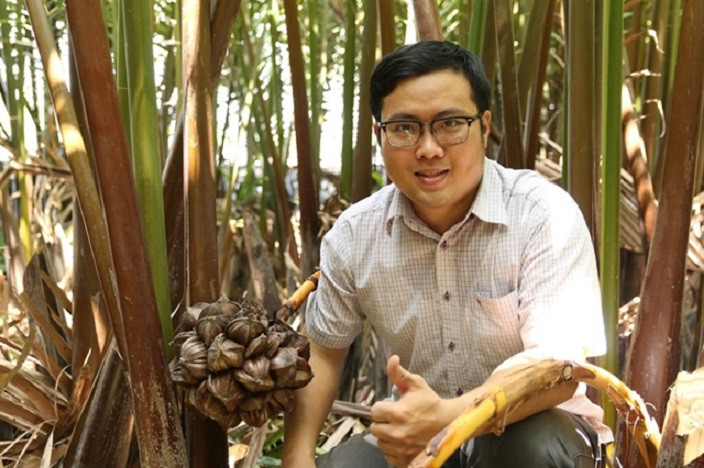
Phan Minh Tiến, whose start-up VIETNIPA develops a range of high-quality, healthy products from nipa palm trees, a natural gift for his hometown Cần Giờ, has helped create steady jobs for locals, protect HCM City’s "green lungs", and give a new direction for farmers in the district and the Mekong Delta amid worsening climate change.
He speaks about the journey of VIETNIPA and upcoming plans.
Can you introduce yourself and tell us what made you decide to set up VIETNIPA ?
I am Phan Minh Tiến, CEO of Vietnam Nipa Corporation.
When it comes to southern Vietnamese culture, the nipa palm tree plays an important role. Its leaves are used for roofing and its fruit for a refreshing drink.
HCM City's outlying district of Cần Giờ District is known as “The World Network of Biosphere Reserves” with more than 900 hectares of natural nipa palm trees, which play an important role in people's lives.
But the nipa palm area is steadily shrinking due to rapid urbanisation and their low economic value and ineffective exploitation.
Seeing the enormous potential of the nipa palm, Vietnam Nipa Corporation (VIETNIPA) has researched and developed organic dietary sweeteners from it with a low glycemic index in line with the trend of using natural, healthy foods.
VIETNIPA seeks to provide safe, organic sweetening solutions not only for Vietnamese consumers but also large sweetener consuming markets such as the US and EU.
Can you elaborate on your project and highlight some of the successes you have achieved?
In the past, after harvesting the nipa fruit, people thought the nipa stem was of no use anymore.
After reading a lot, I realised that the stem of nipa palm offers great value.
By applying a manual tapping technique, similar to a massage, on the portion of the stem, we can stimulate the secretion of the sap.
The harvested sap is then processed to produce a variety of products such as juice, a form of organic energy drink containing multiple vitamins, minerals and natural antioxidants, and syrup and sugar crystals, both organic sweeteners with a low glycemic index and rich in minerals, suitable for people on a diet or seeking to lose weight, vegetarians, and people with type 2 diabetes.
They are used like honey or sugar in preparation and cooking.
Our products are made in organic farming areas meeting international standards (USDA, EU and JAS) and processed using advanced and modern technology and strictly controlled at an ISO 22000, HACCP standard factory to preserve all the flavours and nutritional values of each product.
The products are sold at more than 400 large and small selling points including organic food stores, pharmacies, Co.opmart, An Nam Gourmet, GO!, and Vietnamese and international e-commerce platforms.
VIETNIPA products are also known as a special agricultural product in Cần Giờ in particular, and HCM City in general. Domestic and foreign tourists are fond of the goods and buy them as gifts.
What economic and environmental value does the project bring?
With a green economic model and application of high technology in processing, VIETNIPA has become a market leader in the field of developing economic value from nipa palms, creating more stable jobs for locals, bringing high-quality products to consumers, and contributing to the protection of riverine ecosystems in Cần Giờ District - the "green lungs" of HCM City, and the Mekong Delta.
We have tie-ups with more than 10 farming households to exploit over 10ha of nipa palm with international organic certificates.
Farmers’ incomes from extracting sap have reached VNĐ10-12 million (US$410- $490) a month, 12 times their previous earnings.
If appropriate massage techniques are used, every nipa stem can yield approximately a litre of fresh sap daily and continuously for 30 days.
The sap collection period for nipa palms can be up to 50 years after they mature in their fourth or fifth year.
In addition to economic value, through this project we want to join hands with HCM City authorities in realising its net zero emissions programme. This means the project will contribute to carbon absorption.
According to our statistics, one hectare of nipa palm will absorb around 137 tonnes of carbon, but if this nipa sap is well exploited, the amount of carbon absorption will be even higher. In one month, one nipa stem will offer about 30 litres of sap, which contains carbohydrates that are converted from CO2.
Therefore, we believe that nipa palm is like a CO2 absorption machine, contributing to realise the city's green, sustainable and emission reduction targets.
Nipa palms have also contributed to the creation of a diverse riverine eco-system beneath their canopies and prevent erosion.
The trees are easy to grow even in alum, salty and brackish water and bear fruit around the year. So the nipa palm is a very suitable tree amid the worsening of climate change.
What difficulties did you face when implementing the project?
Being a new product, the most difficult thing was approaching the market, and how to let customers know about the product and its uses.
As a new product with nothing to compare with, supermarkets were also hesitant.
Fortunately, this product is an OCOP -- One Commune One [Speciality] Product -- of HCM City and large supermarkets such as Co.opmart and Big C have created conditions for nipa sap products to enter their retail systems.
After they entered the retail sales system, the number of customers trusting and buying our products has been increasing.
What are your future plans?
VIETNIPA targets to be an exemplary agricultural speciality brand of Cần Giờ and HCM City in general, and has plans in place to promote exports to the US, EU and Japan to enhance the value of Việt Nam nipa palm.
We also want to become a pioneer in the trading of carbon credits through growing nipa palm and exploiting nipa sap.
VIETNIPA aims to provide safe, organic sweetening solutions not only for Vietnamese consumers but also for larger sweetener consuming markets such as the US and EU. VNS